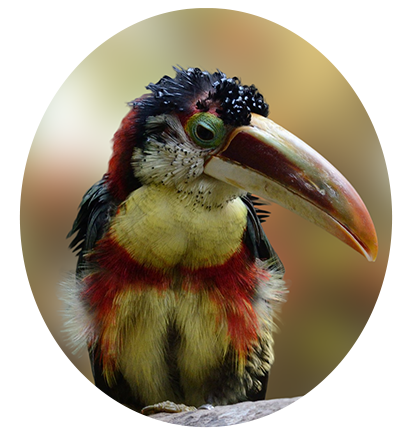

SCIENTIFIC NAME: Pteroglossus beauharnaesii


The Curl-crested Aracari is one of the more spectacularly plumaged araçari and one of the more stranger looking birds.
It is often considered to be exquisitely beautiful and the most attractive and colorful of the smaller toucans.

It is smaller than most toucans and measures 16 - 18 inches long, and weighs 164 - 280 grams.
It has a red back, gray crown, and yellow breast. Underparts contain increasing red blotches and a single red and black breast band. Upperparts are dark green with a dark red mantle and rump.
The bare skin around the eyes is blue and the whitish-yellow facial feathers have hardened black tips. It has an over-sized, heavy, ornately- patterned, multicolored bill with blue and maroon upper bill, ivory lower bill, and an orange tip.
Tail is relatively long, compared to other toucans, and varies in color but has a greenish-bronze dominant color. It has zygodactylous toes as two point forward and two point backwards.
Both sexes are alike, but females have shorter bills.

It calls frequently, but is not as vocal as other araçaris. Its calls are very different from other araçaris and it makes sounds with much variability, fast to slow, deep to soft.
It has very variable, deep "rrek" notes, soft "rrr" to hard, even grunting "grenk" notes, in series. It also makes a loud rising "eeee-yak" yelp that has been reported to sound rather raptor-like.
This species makes sounds with much variability, fast to slow, deep to soft, and even grunting vocalizations.

Primarily a frugivore, but will also take nestlings of birds such as the Yellow- rumped Cacique.

Inhabits forest habitats including subtropical and tropical moist lowlands and swamps. They are commonly found along river edges.

Found in the south-western section of the Amazon Basin, with the Amazon River being its northern range limit. Near the Amazon River, its range extends east to about the Madeira River, while in the southern half of its range it extends east to the Xingu River.
It is generally rare to uncommon, but regularly seen at several localities, including the Tambopata National Reserve in Peru, the Noel Kempff Mercado National Park in Bolivia, and the Cristalino State Park near Alta Floresta in Brazil.

It is known to nest in abandoned tree hollows and cavities, finding hollowed crevices or snags to modify for egg-laying and incubation and even utilizing old woodpecker holes.
Some hollows are the result of a branch break and ensuing rotting of the heart wood from rain over a period of time.
Captive Curl-crested Araçaris may breed in nest boxes with a concave bottom; however, they generally prefer natural nests constructed from palm tree logs, which allows them to dig their nest chambers deeper.
Males tend to modify the nest site and coax the female to it for her approval.
The female lay 3 - 6 pure-white, elliptical-shaped eggs in the hollow nest cavity floor where only a few wood chips may remain. Both parents incubate the eggs for about 16 - 18 days.

SOURCES:
https://faunafocus.com
https://en.wikipedia.org